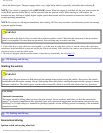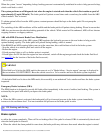
2007 Volvo XC90
Difficult driving conditions
Driving on rough/unpaved surfaces
The Volvo XC90 is designed primarily for on-road driving, and it has excellent handling characteristics on very rough or
unpaved roads.
When driving on poorly maintained or unpaved roads, please keep the following in mind:
● Reduce speed on rough surfaces to minimize possible damage to the vehicle's underbody.
● When driving on soft surfaces such as dry sand or snow, try to avoid stopping if at all possible.
WARNING!
Avoid driving diagonally across steep inclines as this could increase the risk of a roll-over. Try to drive straight up or
down the slope.
If the road is very steep, avoid turning the vehicle around to help avoid the risk of rolling over. Back the vehicle up or
down the incline instead.
NOTE: Avoid driving on steep inclines if the fuel tank is nearly empty. If the flow of fuel to the engine is interrupted due
to the vehicle's angle of inclination, this could result in damage to the three-way catalytic converter. We recommend
keeping the fuel tank at least half full when driving on steep inclines.
Driving through water
The vehicle can be driven through water up to a depth of approximately 18 inches (48 cm), at a maximum speed of 6 mph
(10 km/h).
Take particular care when driving through flowing water.
Clean the electrical connections for trailer wiring after driving in mud or water.
When driving through water, maintain low speed and do not stop in the water.
WARNING!
After driving through water, press lightly on the brake pedal to ensure that the brakes are functioning normally. Water
or mud can make the brake linings slippery, resulting in delayed braking effect.
CAUTION!
● Engine damage will occur if water is drawn into the air cleaner.
● If the vehicle is driven through water deeper than 18 in (48 cm), water may enter the differential and the
transmission. This reduces the oil's lubricating capacity and may shorten the service life of these components.
● Do not allow the vehicle to stand in water up to the door sills longer than absolutely necessary. This could result in
electrical malfunctions.
● If the engine has been stopped while the car is in water, do not attempt to restart the engine. Have the car towed out
of the water.
pg. 124 Starting and driving
file:///K|/ownersdocs/2007/2007_XC90/07xc90_06.htm (10 of 32)12/30/2006 5:53:44 PM


















